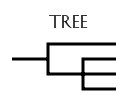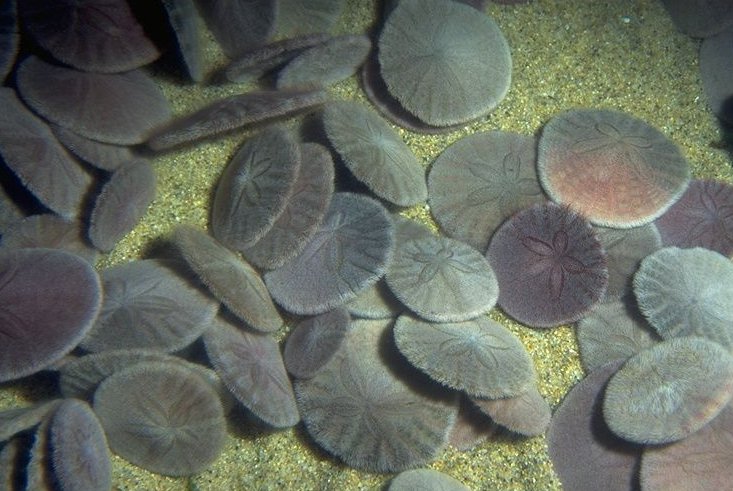| | Eccentric Sand Dollars (Dendraster excentricus)
[© California Academy of Sciences]
Chapter Outline- Description of Deuterostomia
- Classification of Deuterostomia
- Echinodermata
- Hemichordata

Links to external sites will appear in pop-up windows. | | |
The phylum Echinodermata contains five classes.Resources:- Echinodermata - "Shape of Life" series by PBS
- Sea Urchin Development - From an introductory Biology course at Cornell University
- Monterey Bay Aquarium - Bat Star, Brittle Stars, Sand Dollars,Sea Urchins
|
This is the class of Sea Stars or Starfishes. As of 2024, 86 species of Asteroidea have been observed in iNaturalist in the US and 433 throughout the world.- ORDER PERIPODIDA
- SUPERORDER FORCIPULATACEA
- ORDER BRISINGIDA
- ORDER FORCIPULATIDA
- Ochre Sea Star (Pisaster ochraceus) - most iNat observations in the US for Asteroidea - 6 (Omaha Zoo), Ecola SP, OR
- Northern Sea Star (Asterias amurensis) - 6 (KC Zoo)
- ORDER NOTOMYOTIDA
- SUPERORDER SPINULOSACEA
- ORDER SPINULOSIDA
- ORDER VELATIDA
- SUPERORDER VALVATACEA
- ORDER PAXILLOSIDA
- ORDER VALVATIDA
- Crown-Of-Thorns Sea Star (Acanthaster planci) - 8 (Shedd)
- Vermillion Sea Star (Mediaster aequalis) - 8 (Shedd)
- Bat Star (Patiria miniata) - second-most iNat observations in the US for Asteroidea - 6 (Omaha Zoo), 8 (Shedd)
This is the class of Brittlestars. As of 2024, 49 species of Ophiuroidea have been observed in iNaturalist in the US and 194 throughout the world.- SUBCLASS MYOPHIUROIDEA
- INFRACLASS METOPHIURIDA
- SUPERORDER OPHINTEGRIDA
- ORDER AMPHILEPIDIDA
- Western Spiny Brittle Star (Ophiothrix spiculata) - most iNat observations in the US for Ophiuroidea
- ORDER OPHIOLEUCIDA
- ORDER OPHIOSCOLECIDA
- SUBCLASS OPHIURIDEA
This is the class of Sea Urchins. As of 2024, 64 species of Echinoidea have been observed in iNaturalist in the US and 254 throughout the world.- SUBCLASS EUECHINOIDEA
- INFRACLASS ACROECHINOIDEA
- SUPERORDER DIADEMATACEA
- ORDER ECHINOTHURIOIDA
- ORDER PHYMOSOMATOIDA
- ORDER ASPIDODIADEMATOIDA
- ORDER DIADEMATOIDA
- ORDER MICROPYGOIDA
- ORDER PEDINOIDA
- INFRACLASS IRREGULARIA
- SUPERORDER NEOGNATHOSTOMATA
- SUPERORDER ATELOSTOMATA
- ORDER CASSIDULOIDA
- ORDER SPATANGOIDA
- SUPERORDER CALYCINA
- SUPERORDER ECHINACEA
- ORDER ARBACIOIDA
- ORDER CAMARODONTA
- Pacific Purple Sea Urchin (Strongylocentrotus purpuratus) - most iNat observations in the US for Echinoidea - 6 (Omaha Zoo)
- Red Sea Urchin (Mesocentrotus franciscanus) - 6 (Omaha Zoo)
- ORDER TEMNOPLEUROIDA
- SUPERORDER GNATHOSTOMATA
- ORDER CLYPEASTEROIDA
- Eccentric Sand Dollar (Dendraster excentricus) - second-most iNat observations in the US for Echinoidea
- ORDER HOLASTEROIDA
- SUBCLASS PERISCHOECHINOIDEA
This is the class of Sea Cucumbers. As of 2024, 78 species of Holothuroidea have been observed in iNaturalist in the US and 266 throughout the world.- SUBCLASS APODACEA
- ORDER APODIDA
- ORDER MOLPADIIDA
- ORDER POLYCHEIRA
- SUBCLASS ASPIDOCHIROTACEA
- ORDER ASPIDOCHIROTIDA
- Giant Pacific Sea Cucumber (Apostichopus californicus) - 8 (Shedd)
- Apostichopus japonicus - FLKR
- ORDER ELASIPODIDA
- SUBCLASS DENDROCHIROTACEA
- ORDER DENDROCHIROTIDA
- Orange Sea Cucumber (Cucumaria miniata) - most iNat observations in the US for Holothuroidea
This is the class of Feather Stars and Sea Lilies. There are six orders of Crinoidea, all within the subclass Articulata. As of 2024, one species of Crinoidea has been observed in iNaturalist in the US and 68 throughout the world. - ORDER BOURGUETICRINIDA
- ORDER COMATULIDA
- Common Feather Star (Florometra serratissima) - most iNat observations in the US for Crinoidea - Glacier Bay
- ORDER CYRTOCRINIDA
- ORDER HYOCRINIDA
- ORDER ISOCRINIDA
- ORDER MILLERICRINIDA
| |

